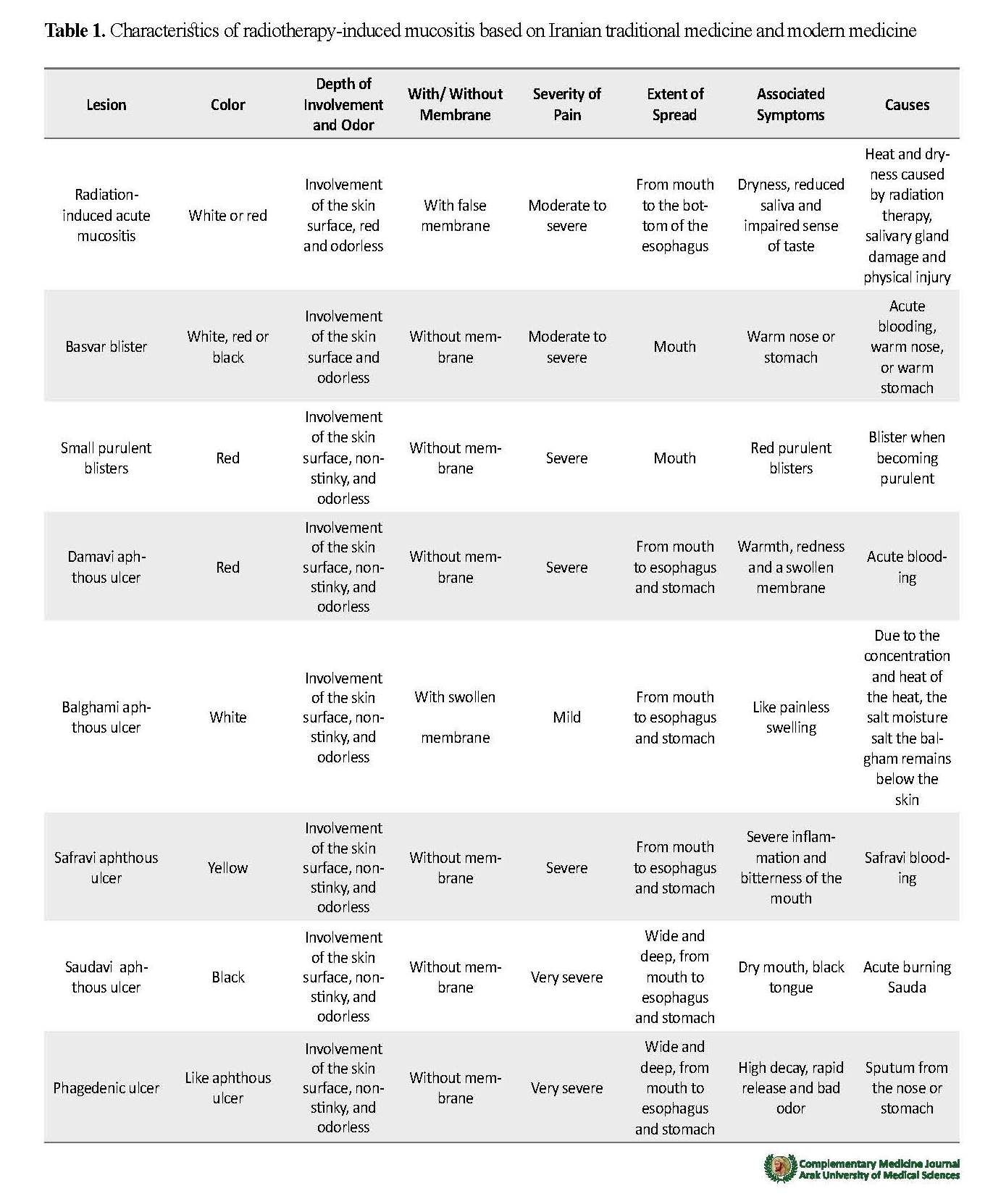Extended Abstract
1. Introduction
The prevalence of cancer is rapidly increasing all over the world. Head and neck tumors account for 4% of all malignant cancers [1]. In the United States, about 100000 new cases of head and neck cancers are diagnosed every year [2]. There are many different therapeutic modalities for the control and treatment of these cancers, one of the most important of which is radiotherapy [3]. Radiation therapy concomitant with chemotherapy can destroy cancer cells by interfering with cell division and reducing cellular half-life [4].
Combined chemotherapy and radiotherapy have the greatest therapeutic effect on the patient, but complications such as oral mucositis are common in these treatments. The incidence of mucositis due to conventional chemotherapy is about 40%, while in severe chemotherapy, it is about 75%, and in head and neck radiotherapy is about 30%-60%. For combined chemotherapy and radiotherapy, its prevalence is 90% [5]. Different interventions have been recommended for the prevention and treatment of radiotherapy-induced mucositis [11, 7].
These interventions mostly are supportive measures such as oral health, nutritional support, salivary status improvement, pain relief, and local anesthetics (e.g. lidocaine, magnesium with antacid and diphenhydramine, sucralfate), ice sucking, growth hormone, and steroidal and nonsteroidal anti-inflammatory drugs, cryotherapy, palifermin, low-level laser therapy, morphine and benzydamine mouthwash [7, 9, 11-13].
The purpose of this study is to compare the radiotherapy-induced mucositis oral ulcers in Iranian traditional medicine and modern medicine. We also review the lifestyle and medications (like mouthwash) recommended by Iranian traditional medicine to treat and prevent mucositis.
2. Materials and Methods
This is a review study. We used all the authentic books of Iranian traditional medicine that were written in Persian or Arabic from the 2nd to 14th centuries, including Canon, Exir-e-Azam, Tibbe-Akbari, Zakhireye Khwarazmshahi, Al-Hawi, Khulasat Al-Tajarob, Sharh Al-Asbab Wa Al-Alamat, Makhzan ul Adviya, and Khulasat ul-Hikmat that mentioned oral diseases. Noor Digital Library was used to study oral ulcers and oral diseases with the present ulcer. The search in these books was done with the keywords of “Dahan” (mouth), “fam” (mouth), “ghala/garhe” (wound), and “varam” (swelling). We also searched PubMed, Web of Science, and Scopus databases using keywords “radiation-induced oral mucositis” and “traditional medicine” for papers published from 1995 to 2018.
3. Results
The pathogenesis of radiotherapy-induced oral mucositis is still unclear. There are five stages involved in the development and recovery of oral mucositis: the inflammatory onset, early epithelial injury, developmental stage, ulcerative stage, and subsequent healing. Each stage results from the direct effect of radiotherapy on the epithelium and the response to cytokines considering the patient’s oral bacterial flora status. The radiation on the mucous membrane of the mouth damages the DNA and mucous membrane and results in the release of oxygen free radicals. From the perspective of Iranian traditional medicine, oral ulcers are categorized based on color, depth, odor, pain severity, with/without membrane, the extent of spread, associated symptoms, and their possible causes. Table 1 presents this classification as well as the various characteristics of radiotherapy-induced mucositis.

Based on Iranian traditional medicine, characteristics of radiotherapy-induced mucositis are mostly similar to damavi (bloody) aphthous ulcer and small purulent blisters. Both of these lesions have the same treatment. Various strategies have been recommended for lifestyle modification to prevent and treat these wounds. Because heat, warmth, and dryness can cause mucositis, certain plants that can create cold and wet temperament and maintain tissue integrity throughout the body and mouth can be used topically and orally for these lesions. These medications can prevent and treat mucositis with their anti-inflammatory, antioxidant and antibiotic properties.
4. Discussion
Given the different views of Iranian traditional medicine on health and disease and the results of various studies, lifestyle modification along with therapeutic measures can be helpful in the treatment of oral mucositis induced by head and neck radiotherapy. One of the limitations of the current study is the lack of studies on therapies for oral mucositis. Also, less attention has been paid to the prevention and treatment of this complication in Iranian traditional medicine. Therefore, it is recommended that various studies be conducted on the efficacy of oral medications and methods mentioned in Iranian traditional medicine resources for the treatment of oral mucositis.
Ethical Considerations
Funding
This article was extracted from a research proposal approved by Traditional and Complementary Medicine Research Center of Arak University of Medical Sciences (Code: 2836).
Authors' contributions
All authors had equally contributed in preparing this article.
Conflicts of interest
The authors declared no conflict of interest.
Acknowledgements
The authors would like to thank the Traditional and Complementary Medicine Research Center for their valuable cooperation.


 , Simin Hemmati2
, Simin Hemmati2 
 , Mohammad Kamali Nejad3
, Mohammad Kamali Nejad3 

 , Seied AmirHossein Latifi *4
, Seied AmirHossein Latifi *4 

 , Seyed Abdolali Musavazadeh5
, Seyed Abdolali Musavazadeh5 


